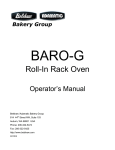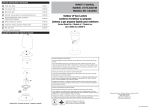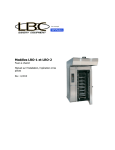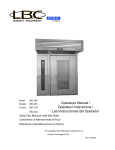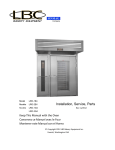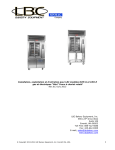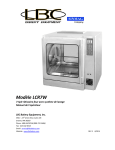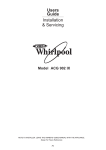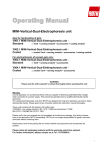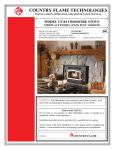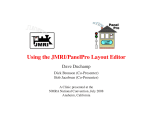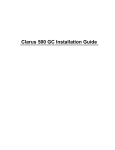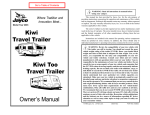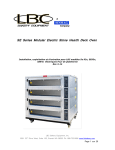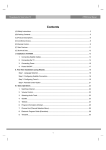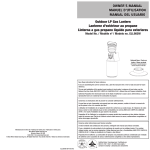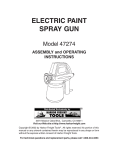Download LRO-1E & 2E Installation, operation & parts
Transcript
A MODELS LRO-1E and LRO-2E Electric Roll-in Rack Ovens Installation and Operations Manual REV 05/2011 READ FIRST THIS MANUAL MUST BE RETAINED FOR FUTURE REFERENCE. READ, UNDERSTAND AND FOLLOW THE INSTRUCTIONS AND WARNINGS CONTAINED IN THIS MANUAL. FOR YOUR SAFETY DO NOT STORE OR USE GASOLINE OR OTHER FLAMMABLE VAPORS AND LIQUIDS IN THE VICINITY OF THIS OR ANY OTHER APPLIANCE. POST IN A PROMINENT LOCATION: I WARNING: IMPROPER INSTALLATION, ADJUSTMENT, ALTERATION, SERVICE OR MAINTENANCE CAN CAUSE PROPERTY DAMAGE, INJURY OR DEATH. READ THE INSTALLATION, OPERATING AND MAINTENANCE INSTRUCTIONS THOROUGHLY BEFORE INSTALLING OR SERVICING THIS EQUIPMENT. DANGER POTENTIALLY HAZARDOUS SITUATION WHICH, IF NOT AVOIDED, COULD RESULT IN DEATH. WARNING POTENTIALLY HAZARDOUS SITUATION WHICH, IF NOT AVOIDED, COULD RESULT IN DEATH OR SERIOUS INJURY. CAUTION POTENTIALLY HAZARDOUS SITUATION WHICH, IF NOT AVOIDED, MAY RESULT IN MINOR OR MODERATE INJURY. NOTICE Helpful operation and installation instructions and tips are present. Model #: Purchased From: Serial #: Location: Date Purchased: Date Installed: Purchase Order #: For Service, Call: ETL File 3028821 2 Rev 6-2010 TABLE OF CONTENTS CHAPTER PAGE 1. TABLE OF CONTENTS ............................................................................... 3 2. WARNING..................................................................................................... 4 3. EQUIPMENT DESCRIPTION ...................................................................... 7 4. INSTALLATION INSTRUCTIONS ............................................................. 10 5. EMERGENCY OPERATION........................................................................ 17 6. GENERAL OPERATION.............................................................................. 18 7. PROGRAMMING.......................................................................................... 19 8. GENERAL MAINTENANCE ....................................................................... 20 9. SAFETY CONSIDERATIONS ..................................................................... 25 10. ILLUSTRATED PARTS BREAKDOWN..................................................... 26 11. WIRING DIAGRAMS................................................................................... 36 12. RESISTANCE CHARTS ............................................................................... 39 13. TROUBLESHOOTING ................................................................................. 40 14. WARRANTY………………………………………………………………...45 ETL File 3028821 3 Rev 6-2010 WARNINGS WARNING THE WATER FROM THE STEAM DRAIN OUTLET IS EXTREMELY HOT AND MAY CAUSE SERIOUS BURNS. PG. 7 NOTICE Left rear drain point is provided. Route to a floor drain. A 1” gap must be provided between oven drain and floor drain. PG. 7 WARNING WIRES ENTERING THE DISCONNECT MAY STILL BE LIVE EVEN WHEN THE SWITCH IS TURNED OFF. SWITCH THE MAIN BREAKER AT THE WALL TO “OFF” WHEN SERVICING THE OVEN TO REDUCE THE RISK OF FIRE, THE APPLIANCE IS TO BE MOUNTED ON FLOORS OF NON-COMBUSTIBLE CONSTRUCTION WITH NON-COMBUSTABLE FLOORING AND SURFACE FINISH AND WITH NO COMBUSTIBLE MATERIAL AGAINST THE UNDERSIDE THEREOF, OR ON NON-COMBUSTABLE SLABS OR ARCHES HAVING NO COMBUSTIBLE MATERIAL AGAINST THE UNDERSIDE. SUCH CONSTRUCTION SHALL EXTEND A MINIMUM OF 12-INCHES BEYOND THE EQUIPMENT ON ALL SIDES. See fig. 1 CAUTION PG. 8,19 PG. 10 Fig. 1 Floor Construction ETL File 3028821 4 Rev 6-2010 WARNINGS CONT’D DO NOT UNLOAD THE RACK FROM THE OVEN WHILE THE CARRIER IS IN THE LIFT POSITION. LOADED RACKS CAN BE EXTREMELY HEAVY. PG. 17 WARNING DO NOT REMOVE A FLAMING PRODUCT FROM THE OVEN. SEVERE BURNS AND PROPERTY DAMAGE CAN RESULT. PG. 17 CAUTION THIS APPLIANCE, WHEN INSTALLED, MUST BE ELECTRICALLY GROUNDED IN ACCORDANCE WITH LOCAL CODES, OR IN THE ABSENCE OF LOCAL CODES, WITH THE NATIONAL ELECTRICAL CODE, ANSI/NFPA 70-1996. PG. 10 FOR INSTALLATION IN CANADA THE INSTALLATION MUST BE IN ACCORDANCE WITH CAN/CGA-B149.1&2 OF THE INSTALLATION CODE, AND LOCAL CODES WHERE APPLICABLE. ALL ELECTRIC WIRING MUST BE IN ACCORDANCE WITH THE CURRENT CANADIAN ELECTRICAL CODE, C22.1 PART 1. GROUNDING THIS APPLIANCE MUST CONFORM TO CANADIAN ELECTRICAL CODE, CSA C22.2. PG. 11 INSTALLATION OF THE UNIT MUST BE DONE BY PERSONNEL QUALIFIED TO WORK WITH ELECTRICITY AND PLUMBING IMPROPER INSTALLATION CAN CAUSE INJURY TO PERSONNEL AND /OR DAMAGE TO EQUIPMENT. UNIT MUST BE INSTALLED IN ACCORDANCE WITH ALL APPLICABLE CODES. PG. 11 DO NOT ALLOW ANY PART OF YOUR BODY TO BE UNDER THE OVEN DURING THE LIFTING PROCESS. KEEP EVERYONE CLEAR FROM THE OVEN IF IT SHOULD FALL. PG. 11 It is imperative that a mechanical exhauster is installed, and a pressure sensitive switch is installed at the collar of the hood. If a negative draw of 0.6 is not achieved, the burner will not come on. PG. 14 NOTICE No other exhaust systems may be connected to this system. Do not try to vent or exhaust another appliance into this hood. PG. 14 WARNING WHEN REMOVING THE RACK OR PRODUCT FROM THE RACK WEAR OVEN MITTS TO AVOID SERIOUS BURNS. PG. 17 NOTICE Always ensure the grease filters supplied with the oven are used. Replacement filters may be ordered from an LBC Bakery service representative. PG. 15 CAUTION IF BLOWER ROTATION IS INCORRECT, IT WILL CAUSE SEVERE DAMAGE TO HEAT EXCHANGER PG. 16 CAUTION CAUTION SHOULD BE TAKEN WHEN ENCLOSING HOOD TO CEILING AND OVEN IS UNDER A FIRE SPRINKLER; HOOD EXHAUST STACK WILL EMIT HEAT. PG. 8 WARNING CAUTION WARNING WARNING NOTICE ETL File 3028821 5 Rev 6-2010 WARNINGS CONT’D WARNING NOTICE NOTICE WARNING NOTICE NOTICE NOTICE WARNING NOTICE THIS LBC BAKERY OVEN PRODUCES HUMIDITY THAT CAN CAUSE THE INTERIOR FLOORING AND ADJACENT EXTERIOR FLOORING TO BECOME SLIPPERY. USE EXTREME CAUTION WHEN WALKING ON A WET OR DAMP FLOOR. PG. 18 The ambient temperature outside the oven should not exceed 104° F (40° C). This includes the temperature of the air above and around the oven. PG. 18 During the first few hours of operation you may notice a small amount of smoke coming off of the oven, and a faint odor from the smoke. This is normal for a new oven and will disappear after the first few hours of use. PG. 18 WHEN THE LOADING DOOR IS OPENED, HOT AIR AND STEAM ARE RELEASED FROM THE OVEN INTERIOR. TO AVOID BURNS OPEN DOOR SLOWLY AND KEEP YOUR FACE AND HANDS CLEAR OF THE OPENING. ALL INTERIOR SURFACES ARE VERY HOT. DO NOT TOUCH ANYTHING WITHOUT OVEN MITTS. PG. 18 Service on this, or any other, LBC BAKERY appliance must be performed by qualified personnel only. Consult your authorized service agency directory or call the factory at 1-888-722-5686 or go to WWW. LBCBAKERY.COM for the service agent nearest you. PG. 20 To maintain optimum safety and performance for LBC BAKERY oven models LRO-1E & LRO-2E, it is recommended that a program of scheduled periodic maintenance be implemented. It is the sole responsibility of the user to establish, schedule and enforce such a program. Although the actual service interval will vary depending on the environment in which the equipment is operating, it is recommended the following be done by an LBC BAKERY authorized service agency at least every 6 months. PG. 20 For periodic maintenance and repairs, electrical diagrams are included in this manual and with the oven (on the back of the control door). PG. 20 SINCE RESETS FOR THE CIRCULATION BLOWER MOTOR AND THE LIFTER MOTOR / ROTATOR MOTOR ARE AUTOMATIC, ALL POWER TO THE OVEN MUST BE TURNED OFF BEFORE SERVICING. PG. 21 If shutter settings are to be adjusted differently than the recommended factory settings, the best results will be obtained if you; (A) Start with the factory settings; (B) Close shutters to lighten a product in a given area- do not open shutters to darken a product; (C) Do not move a shutter more than 1/32” or 1mm (see step gauge and shutter setting illustration) at any one time; (D) Be sure all settings for left hand shutters match those for right hand shutters; and (E) Do not adjust more than two shutters per side per time (four shutters total). ETL File 3028821 6 PG. 21 Rev 6-2010 EQUIPMENT DESCRIPTION Data Plate On this plate you will find the oven model, serial number, electrical ratings, (BTU’s, and gas type for gas ovens), and clearance specification. Data plate is located behind the controller door on component cover. Exterior Construction The LRO-1E exterior dimensions are 55” (139.7 cm) wide x 105” (266.7 cm) high x 51” (129.5 cm) deep at the base. The LRO-2E exterior dimensions are 72” (182.9 cm) wide x 105” (265.4 cm) high x 62” (157.5 cm) deep at the base. The Top, Front, Back, and Sides are constructed of stainless steel with 5 inches of insulation. Floor level loading. Type I or Type II hood with single point exhaust connection complying with Uniform Mechanical Code and NFPA 96: State, County and local code may vary; always check with local code officials. The oven door is constructed of stainless steel with a full height single pane window and an interior releasing mechanism. Interior Construction The LRO-1E cavity dimensions are 28” (92.71 cm) wide x 75” (190.5 cm) high x 39” (99.06 cm) deep at its deepest point. The interior is constructed of stainless steel. The LRO-2E cavity dimensions are 40” (92.71 cm) wide x 75” (190.5 cm) high x 50” (99.06 cm) deep at its deepest point. The interior is constructed of stainless steel. Smooth and simple rack loading and unloading. Gentle rack lift and rotation protects delicate products. The rack is designed to hold up to twenty 18”x 26” sheet pans. A built in steam generator produces steam quickly. Fully adjustable airflow for even cooking. Controls Large digital display which is easy to understand and operate. Icon-driven (touch) panel allows for easy operation. Pre-Programmable Product Selections. Heat Loss Compensation for consistent baking. Technical The oven requires a 208/240 VAC three-phase power supply and a 115 VAC single phase power supply for controls. The oven requires no clearance from combustible wall construction. WARNING THE WATER FROM THE STEAM DRAIN OUTLET IS EXTREMELY HOT AND MAY CAUSE SERIOUS BURNS. Steam Drain Outlet Water exits the steam generating system through this outlet It is located at the lower right-hand jamb or left rear corner of the oven. NOTICE ETL File 3028821 Left rear drain point is provided. Remove the plug from the location required and route to a floor drain. A 1” gap must be provided between oven drain and floor drain. 7 Rev 6-2010 EQUIPMENT DESCRIPTION CONT’D Floor Drain This drain (customer supplied) receives the excess water from the steam generating system. Rack Carrier When the loading door is closed, the rack carrier lifts and rotates the oven rack. Rack Stop The two rack stops are located on the carrier and secure the oven rack in place during baking. The leading edge of the forward stop must be manually flipped down to unload the oven rack. The stop will automatically return to the up (loading) position when the rack is removed. Hood Steam and burner exhaust is discharged into the hood. Grease is channeled to and collected in a grease cup for later removal. Hood Exhaust Cooking fumes pass through a duct to the hood exhaust outlet. A customer-supplied exhaust blower is required. The hood can be wired to the external device terminals in the service box. This insures the hood is on whenever the oven is on. The “POWER” switch on the oven control panel activates the blower. The blower must be running before the oven will operate. A factory installed airflow switch disables heat until airflow exists. 120V Circuit Breakers Power to run the control panel and hood blower can be disconnected at these points. Switch to “OFF” when servicing oven or blower. WARNING WIRES ENTERING THE DISCONNECT MAY STILL BE LIVE EVEN WHEN THE SWITCH IS TURNED OFF. SWITCH THE MAIN BREAKER AT THE WALL TO “OFF” WHEN SERVICING THE OVEN 3-Phase Circuit Breaker This disconnect provides short circuit protection for the circulation blower motor. Switch to “OFF” when servicing the oven. Element Circuit Breakers There are circuit breakers installed to provide short circuit protection for the elements. Main Power Connection A 3-pole terminal block located in the upper control panel for the incoming high voltage power connection. See Page 14 Control Connection A 2-pole terminal block and 1-pole circuit breaker is located above the controls for power hook up for the controls. See Page 14 Hood Supply A 1-pole circuit breaker is provided to supply power to the ventilator hood. CAUTION CAUTION SHOULD BE TAKEN WHEN ENCLOSING HOOD TO CEILING AND OVEN IS UNDER A FIRE SPRINKLER; HOOD EXHAUST STACK WILL EMIT HEAT. ETL File 3028821 8 Rev 6-2010 EQUIPMENT DESCRIPTION CONT’D Circulation Blower Vent Blower Controls Element circuit breakers Interior Door Release This door release allows the door to be opened from inside the oven. ETL File 3028821 9 Rev 6-2010 INSTALLATION INSTRUCTIONS CAUTION TO REDUCE THE RISK OF FIRE, THE APPLIANCE IS TO BE MOUNTED ON FLOORS OF NON-COMBUSTIBLE CONSTRUCTION WITH NON-COMBUSTABLE FLOORING AND SURFACE FINISH AND WITH NO COMBUSTIBLE MATERIAL AGAINST THE UNDERSIDE THEREOF, OR ON NONCOMBUSTABLE SLABS OR ARCHES HAVING NO COMBUSTIBLE MATERIAL AGAINST THE UNDERSIDE. SUCH CONSTRUCTION SHALL EXTEND A MINIMUM OF 12-INCHES BEYOND THE EQUIPMENT ON ALL SIDES. See fig. 1 Page 4. Receiving the Oven Upon receipt, check for freight damage, both visible and concealed. Visible damage should be noted on the freight bill at the time of delivery and signed by the carrier's agent. Concealed loss or damage means loss or damage which does not become apparent until the merchandise has been unpacked. If concealed loss or damage is discovered upon unpacking, make a written request for inspection by the carrier's agent within 15 days of delivery. All packing material should be kept for inspection. Do not return damaged merchandise to LBC Bakery Equipment. File your claim with the carrier. Pre-Installation Check the area where the oven is to be installed for the following: • No electrical conduit or wires are to be under the floor of the oven. • The oven must be mounted on a non-combustible surface. This includes the structure beneath the floor. The floor must be level within 3/4”. See Fig. 1 Page 4, and above CAUTION! • Ceiling height above the oven should be sufficient to allow servicing the lifter, vent, and blower motor assemblies. The maximum height needed for tilting the oven up is 105 inches. • Clear access is needed to the roof or exterior of the facility for hood exhaust. Check local codes for correct venting. • Caution should be taken when enclosing hood to ceiling and oven is under a fire sprinkler; hood exhaust stack will emit heat. • Access is needed for an air-gap drain in the rear left corner of the oven. • Adequate space is needed in front of the oven to load and unload racks. Racks are hot and need space to cool. • The hood exhaust will need at least 600 CFM of make-up air. • Local and national codes will require an electrical shut-off within a reasonable distance to the oven. • Local and National codes will require access to a manual Gas Shut-off. • The door swing will need to be clear to allow adequate loading and unloading of the oven. Check the space next to the oven and be sure it does not interfere with the door. Un-Crating The oven is shipped in one piece. (It can be uncrated and split in two for easier installation where door openings are limited to 36 inches.) Move the large oven crate into the room, near where it is to be installed. Allow clear access for a forklift or lifting apparatus at the top end of the oven. The bottom end of the oven crate is beveled at the skids. Check the crate for damage that may have occurred in shipping. Remove crating materials and plastic wrap from the oven. Remove the heat exchanger vent duct from the skid. CAUTION ETL File 3028821 THIS APPLIANCE, WHEN INSTALLED, MUST BE ELECTRICALLY GROUNDED IN ACCORDANCE WITH LOCAL CODES, OR IN THE ABSENCE OF LOCAL CODES, WITH THE NATIONAL ELECTRICAL CODE, ANSI/NFPA 70-1996. 10 Rev 6-2010 INSTALLATION CONT’D CAUTION WARNING WARNING FOR INSTALLATION IN CANADA THE INSTALLATION MUST BE IN ACCORDANCE WITH CAN/CGA-B149.1&2 OF THE INSTALLATION CODE, AND LOCAL CODES WHERE APPLICABLE. ALL ELECTRIC WIRING MUST BE IN ACCORDANCE WITH THE CURRENT CANADIAN ELECTRICAL CODE, C22.1 PART 1. GROUNDING THIS APPLIANCE MUST CONFORM TO CANADIAN ELECTRICAL CODE, CSA C22.2. INSTALLATION OF THE UNIT MUST BE DONE BY PERSONNEL QUALIFIED TO WORK WITH ELECTRICITY AND PLUMBING. IMPROPER INSTALLATION CAN CAUSE INJURY TO PERSONNEL AND /OR DAMAGE TO EQUIPMENT. UNIT MUST BE INSTALLED N ACCORDANCE WITH ALL APPLICABLE CODES. DO NOT ALLOW ANY PART OF YOUR BODY TO BE UNDER THE OVEN DURING THE LIFTING PROCESS. KEEP EVERYONE CLEAR FROM THE OVEN IF IT SHOULD FALL. Raising Raise the oven to its vertical, upright position with the use of a forklift or other lifting device. Provide a means to lower the oven to the floor without dropping. • Raise top end of each oven skid with a forklift until the oven is at 60° from horizontal. (If a forklift is not available, use a pallet jack and successive stacks of pallets to raise the oven. DO NOT LIFT THE OVEN BY HAND). Tilt the oven to the vertical position by hand from the raised position • Ease the oven to the floor and do not allow it to fall over. OVEN HALVES ARE UNSTABLE. Assembly Note: Single oven halves come pre-bolted and will not require bolting together of oven halves. • Move the erected oven halves to where the mating faces are 2-3 feet apart. • Place the oven floor on the ground against the right wall of the oven and 6 inches forward of the rear wall. • Carefully raise the front edge of the right wall with a pry bar and slide the floor back until it touches the back wall. • Slide the right half of the oven toward the left half until the two halves mate together. Note: Nudge the halves with pry bars to move them. Do not force parts to fit. • Bolt the inner skin together at the rear, top and front header using 5/16-18 gimlet point screws provided. • Install ½-13x1 hex head bolts, nuts, and lock washers at the joint in the rear base, rear top frame and header. Snug all bolts tight. • Install the insulation provided at the center joint so that there are three layers and no voids. • Slide the rear joint panel into the upper frame at the back of the oven and drop it into the lower frame to close the back of the oven. • Place the top insulation cover in place and secure it to the outer ceiling panel with the drill tip screws provided. ETL File 3028821 11 Rev 6-2010 INSTALLATION CONT’D Assembly Cont’d • Raise the front header cover into position between the front jambs and slip it over the header frame until it is flush with the front. Install two drill-tip screws through the top flange of the header cover. Install #10x¾ stainless steel sheet metal screws through the bottom flange of the header cover. Use care to keep the gasket in place. • Install ¼-20x½” truss head stainless steel screws through the inner ceiling joint, inside the oven. • Place the floor clamp strips around the inside walls of the oven. Install, using ¼-20x½” truss head screws, washers and lock-washers; longer screws are provided for the overlapping joints at the corners. Do not tighten these screws until the oven has been placed at its final location and leveled. If needed loosen lifter assembly mounting bolts and move the lifter assembly around until the rotator assembly is clear of the lifter frame and all moving parts are free (this should be where the lifter is centered on the rotator shaft). Anchor the lifter assembly in place with the fasteners provided. • • Remove the snap ring, square washer and shipping spacer from the rotator shaft. • Remove the rack carrier from the bottom of the hood crate. Install the carrier on the rotator shaft inside the oven using the snap ring provided. Install the four set-screws in the carrier-shaft collar. Do not tighten yet, as this will allow the carrier to be aligned later. • Connect the white plastic connector from the main harness to the white plastic connector on the lifter harness. • Check the location of all of the wires to ensure that they are free of sharp edges or moving parts. • Install the front transport wheel on the left jamb by raising the oven with a crowbar then lowering the left front jackscrew, located behind the control door on the bottom. Use the pan head machine screws provided to secure the removable front transport wheel. • Make sure both front leveling points are raised before transporting oven to avoid floor damage. 1) Left front jackscrew, located behind the control door on the bottom of the oven. 2) Right front jackscrew located at the top right (Operators viewpoint) of the oven. • Extend the rear transport wheels by lowering the leveling jack-screws in the rear corners on top of the oven. ETL File 3028821 12 Rev 6-2010 INSTALLATION CONT’D Setting Remove the vinyl protective coating from all of the exterior surfaces. Roll the oven into its final installed position. (You may wish to install the hood before locating the oven.) Adjust the left front leveling screw until the weight is removed from the wheel assembly. Remove the wheel assembly. For right hand doors: adjust the rear leveling screws and the left front leveling screws until the left jamb is level from left to right and front to back. Lock the left front adjusting screw in place. Install the loading door. • Remove the loading door from its crate. • Stand the door upright and move it into place with a hand truck. • Align and screw the hinge plate to the door jamb. • Use care to avoid damaging the door seal. Adjust the right front leveling screw until the gap at the top of the door opening is even all across. Check the gap along the left side of the door. Recheck the level of the oven. For left hand doors: adjust the rear leveling screws and the right front leveling screws until the right jamb is level from left to right and front to back. Lock the right front adjusting screw in place. Install the loading door. • Remove the loading door from its crate. • Stand the door up right and move it into place with a hand truck. • Raise the door hinges over the jamb hinges with the hand truck and lower into place. • Use care to avoid damaging the door seal. Adjust the left front leveling screw until the gap at the top of the door opening is even all across. Check the gap along the right side of the door. Recheck the level of the oven. Loosen the floor clamp screws around the perimeter of the oven floor. Walk around the stainless floor until it is in full contact with the concrete floor. Retighten the floor clamp screws. Drill the floor with a 3/8” diameter drill to accept the concrete floor anchors. • Mark the drill bit at 1-1/2” from the end with tape. Drill until the mark is at the top of the stainless steel floor. Do not drill too deep. • Clean the holes of concrete dust. • If the oven is mounted on stone or ceramic tile, extend the holes and the anchors into the concrete substrate. Install the anchors in the holes and set in place with the anchor-setting tool. (Note: One good solid blow is better than many little taps.) Install the flat head screws in the anchors. Use the anchor washers in the holes at the middle of the floor these are larger anchor holes. Adjust the Loading door latch to ensure a good seal around the door. Do not over tighten the door. Adjust the floor seal at the bottom of the door with door closed to insure a good seal to the floor when the door is closed. This is important for as even of bake as possible. ETL File 3028821 13 Rev 6-2010 INSTALLATION CONT’D Check the level of the rack carrier shaft. Place an accurate level on the top of the carrier and rotate the carrier to the four points of the compass. The level bubble should be in the same position relative to the carrier when rotated. If not, remove the carrier and level the shaft. • Loosen the four corner screws on the rotator shaft level adjusting plate on the under side of the inner ceiling. Remove the two remaining screws. • Move the shaft manually until the shaft is level in all four directions. • Retighten the four corner screws. Drill two new screw holes in the adjusting plate with a #7 drill bit and tap #¼-20. Install the two remaining screws to lock the shaft level in place. NOTICE It is imperative that a mechanical exhauster is installed, and the pressure sensitive switch provided is connected at the collar of the hood. If a negative draw of 0.6” W.C. is not achieved, the burner will not come on. NOTICE No other exhaust systems may be connected to this system. Do not try to vent or exhaust another appliance into this hood. Installing the Hood • • • • • • • • • • • • • Remove the hood from the hood crate. Place the body of the hood on the floor with the open side down. Use cardboard or other protective material to avoid scratches. Remove all protective vinyl coatings and place the hood side support trim on each side of the hood and screw to the front of the hood with (4) #1/4-20 stainless steel truss head machine screws and spacer bushings. Install (4) #10-32 truss head stainless steel machine screws through the side support trim and into the top of the hood. Attach the rear trim to the opposite end of the hood side support trim using (4) ¼-20 truss head stainless steel machine screws. Place the combustion exhaust duct (shipped strapped to the oven skid) on the top of the heat exchanger exhaust opening. Lift the hood and trim assembly and place it over the top of the oven so that the side and rear trim rest on the top of the oven. Push the hood assembly toward the rear of the oven and align the vent exhaust opening and the exhaust duct opening with the associated ducts on the oven. Attach the hood side support trim and the rear trim to the top of the oven with ¼-20 stainless steel truss head machine screws. Attach the hood to the exhaust and vent ducts using #10 stainless steel sheet metal screws. Install the hood airflow sensor tube at the hood collar opening and at the airflow switch in the lifter assembly located at the top of the oven. Double-check this connection for leaks or crimps in the tube or hose. Install the hood deflector using #10-32 stainless steel round head machine screws at the back of the deflector and #10-32 stainless steel truss head machine screws at three holes at the front edge of the deflector. Place the three hood filters and the filler channel in the hood filter holder and onto the front lip of the hood. Place the hood grease cup on the rear lip of the hood at the drain opening. Install the hood valance on the front of the hood. ETL File 3028821 14 Rev 6-2010 INSTALLATION CONT’D Connecting Utilities • Connect the electrical service connection to the oven. Consult the data plate for specific current and voltage ratings. 208, 240 or 480 three phase and 120V single phase required. Wire in compliance with local requirements and the National Electric Code. • Connect water supply to the oven at the water solenoid valve at the top left corner of the oven. Water supply must be between 20 and 80 PSI at all times with a water flow of 9 gallons per minute max only while steaming. Steam is only used 10 seconds every ½ hour so water consumption will be very low. Provide a water shut-off valve near the oven for servicing. • Connect the drain to the oven. Water drained from the oven will reach temperatures near boiling. The drain line must be provided with an air gap to prevent back siphoning. Start-up • • • • • • • • • Remove all protective coatings from the oven surface, inside and out. Confirm that all electrical connections are proper and all covers are in place. Confirm that the oven is properly grounded. Turn on electrical power to the oven. Turn on all circuit breakers located in the electrical compartment. Press and hold the power button until the display turns on. The oven interior light should turn on and the control display should light up. Close the loading door. The lifter and rack carrier should raise and begin to rotate. Open the door and allow the carrier to stop rotating. Check the position of the alignment of the carrier to the door with no load on rack carrier. If the carrier needs adjustment, remove the chrome caps from the center channel on the rack carrier. Loosen the four set-screws that lock the carrier to the shaft. Rotate the carrier until it aligns with the door and retighten the set-screws. Replace the chrome caps. Place a “B” type oven rack in the oven. Measure the spacing between the oven rack top channels and the rack carrier. The space between the carrier lip and the top flange of the rack channel should be approximately ¾”. Adjust the lifter micro-switch mount on the lifter body to compensate. Close the loading door and check the direction of rotation of the blower motor. The motor should rotate counterclockwise when viewed from the top. If motor runs clockwise when viewed from the top reverse L1 and L2 at the power supply side of the motor circuit breaker. This is very important for an even bake. Heat the oven to 300°F. (Refer to the programming section of this manual for control operating instructions.) Check the oven for gas leaks, excessive smoke, vibration and general operation. NOTICE Always ensure the grease filters supplied with the oven are used. Replacement filters may be ordered from an LBC Bakery service representative. ETL File 3028821 15 Rev 6-2010 INSTALLATION CONT’D Do not hook up incoming 208/240/480V here. Hook up to terminal block below. Incoming 120V power connection here at top. Incoming 208/240/480V hooked up below. See bottom of page. CAUTION IF BLOWER ROTATION IS INCORRECT, IT WILL CAUSE SEVERE DAMAGE TO HEAT EXCHANGER 208/240/480 3 Phase power hooked up inside control panel just above element circuit breakers. Oven Ground ETL File 3028821 16 Rev 6-2010 EMERGENCY OPERATION WARNING WHEN REMOVING THE RACK OR PRODUCT FROM THE RACK, WEAR HOT MITTS TO AVOID SERIOUS BURNS. Power Failure Do not attempt to operate oven. Turn the power to “OFF”. Remove the product from the rack. DO NOT UNLOAD THE RACK FROM THE OVEN WHILE THE WARNING CARRIER IS IN THE LIFT POSITION. LOADED RACKS CAN BE EXTREMELY HEAVY. Product fire in the baking chamber 1. Turn power switch to “OFF”. 2. Wait until the fire has gone out before opening the door. DO NOT REMOVE A FLAMING PRODUCT FROM THE OVEN. WARNING SEVERE BURNS AND PROPERTY DAMAGE CAN RESULT. ETL File 3028821 17 Rev 6-2010 GENERAL OPERATION WARNING THIS LBC BAKERY OVEN PRODUCES HUMIDITY THAT CAN CAUSE THE INTERIOR FLOORING AND ADJACENT EXTERIOR FLOORING TO BECOME SLIPPERY. USE EXTREME CAUTION WHEN WALKING ON A WET OR DAMP FLOOR. NOTICE The temperature outside the oven should not exceed 104° F (40° C). This includes the temperature of the air above and around the oven. NOTICE During the first few hours of operation you may notice a small amount of smoke coming off of the oven, and a faint odor from the smoke. This is normal for a new oven and will disappear after the first few hours of use. WHEN THE LOADING DOOR IS OPENED, HOT AIR AND STEAM ARE RELEASED FROM THE OVEN INTERIOR. TO AVOID BURNS OPEN DOOR SLOWLY AND KEEP YOUR FACE AND HANDS CLEAR OF THE OPENING. ALL INTERIOR SURFACES ARE VERY HOT. DO NOT TOUCH ANYTHING WITHOUT OVEN MITTS. WARNING Typical Operation • Preheat oven to desired temperature and allow oven to saturate for 20 minutes. • The steam generator absorbs heat and normalizes temperature in the cooking chamber. • Select a cooking program from the main menu of pre-saved programs or set a manual program. When selected, the temperature setting changes to the correct temperature for the product. See LRO operation manual supplied or online @ WWW.LBCBakery.con for programming information. • Push a rack full of product into the oven, sliding it onto the rack carrier until rack stop locks. • The door of the oven is closed and the rack is lifted off of the floor, allowing it to rotate smoothly. • Once start button is pressed, if a steam time has been set, water flows into the steam generator and cascades through the labyrinth of heat reserves, converting the water into steam, which condenses on the cool food product. This will also start the countdown timer. • When the steam cycle ends (within 60 seconds), the circulation blower starts and air is blown past the heat exchanger and through the rack full of product. • The rotation of the rack insures that the product is cooked evenly throughout the rack. If venting is desired, such as with breads, the vent cycle is selected when the program is started. • The vent opens for a limited time, allowing dry air to be drawn into the oven and forcing moist air out into the hood. • The computer control manages all of the timing and temperature functions and sounds an alarm at the end of the baking cycle. • Open the cooking chamber door and wait until the rack is rotated so that it is aligned with the door. • Using oven mitts release the rack stop latch at the top of the rack and remove the rack from the oven. ETL File 3028821 18 Rev 6-2010 GENERAL OPERATION CONT’D Loading Procedures Set the controls. See Operation Manual supplied or online @ WWW.LBCBakery.con for programming information. Open the door (slowly). Wait for the rack carrier to stop and lower. Confirm that the rack stop is in the loading (LEADING FLAP UP) position. Align the top channels of the oven rack with the rack carrier and push the rack past the rack stop. Close the loading door. The rack carrier will automatically lift the rack and begin to rotate. Begin baking by pressing START. A buzzer will sound when baking is completed. Unloading Procedure Press the STOP button or open the loading door to turn off the buzzer. You can view your product through the window. If it appears ready, SLOWLY open the loading door about 6 inches. Let steam and hot air escape from the opening (to be removed through the hood.) Open the door completely. The rack carrier will come to a stop and the rack will lower. USING OVEN MITTS, flip the rack stop to the unloading (LEADING FLAP DOWN) position. Remove the rack from the rack carrier. Close the loading door. Shut Down Procedure 1. 2. Turn the power switch to the “OFF” position. For lengthy shutdown periods or maintenance, turn power off at the 208/240 volt and 120 volt power disconnects. WIRES FROM THE SERVICE ENTRANCE MAY STILL BE LIVE, WARNING EVEN WHEN SWITCHES ARE TURNED OFF. TURN POWER OFF AT MAIN BREAKER BEFORE SERVICING. 3. Switch the oven disconnect to “OFF”. SEE PROGRAMMING MANUAL FOR CONTROL PANEL INSTRUCTIONS ETL File 3028821 19 Rev 6-2010 GENERAL MAINTENANCE NOTICE Service on this, or any other, LBC BAKERY appliance must be performed by qualified personnel only. Consult your authorized service agency directory or call the factory at 1-888-772-5686 or go to WWW. LBCBakery.COM for the service agent nearest you. NOTICE To maintain optimum safety and performance for LBC BAKERY Rack oven models LRO-1E & LRO-2E, it is recommended that a program of scheduled periodic maintenance be implemented. It is the sole responsibility of the user to establish, schedule and enforce such a program. Although the actual service interval will vary depending on the environment in which the equipment is operating, it is recommended the following be done by an LBC BAKERY authorized service agency at least every 6 months. Preventative Maintenance 1. 2. 3. 4. 5. 6. 7. 8. 9. 10. 11. 12. 13. 14. 15. Verify hood exhaust air-pressure switch is operating properly. Check for bad elements, equal amp draw on all. Check loading door handle & striker adjustment and verify the mounting screws are tight and seals are in good condition. Check interior loading door release for proper operation. Clean hood filters with soap and water. Check and tighten any loose screws on both the interior and exterior of the oven. Check the rack lift assembly for proper operation. Adjust limit switch as needed. Check rotator alignment on the rack rotator assembly. Lubricate the drive chain if applicable. Clean flour and dust that may have accumulated on top of the oven and circulation blower motor. Check steam system for proper operation and drainage. Clean / de-scale steam system spray nozzles and drain pain, if needed. Check vent for proper operation. Check loading door switch actuator for proper adjustment. Check the loading door seal and door sweep condition. Check control panel for proper operation. NOTICE For periodic maintenance and repairs, electrical diagrams are included in this manual and available @ LBCBakery.com ETL File 3028821 20 Rev 6-2010 GENERAL MAINTENANCE CONT’D WARNING SINCE RESETS FOR THE CIRCULATION BLOWER MOTOR AND THE LIFTER MOTOR / ROTATOR MOTOR ARE AUTOMATIC, ALL POWER TO THE OVEN MUST BE TURNED OFF BEFORE SERVICING. Motor Reset One of the overload protectors may require resetting if the circulation blower does not start, if it quits, or if the rack does not lift and rotate with the loading door closed. This is done automatically; nothing need be done by the operator. After a few minutes, the oven should reset and normal operation should resume. If it has not reset after fifteen minutes, call for service. If shutter settings are to be adjusted differently than the NOTICE recommended factory settings, the best results will be obtained if you (A) start with the factory settings, (B) close shutters to lighten a product in a given area- do not open shutters to darken a product, (C) do not move a shutter more than 1/32” or 1mm (see step gauge illustration) at any one time, (D) be sure all settings for left hand shutters match those for right hand shutters, and (E) do not adjust more than two shutters per side per time (four shutters total). Uneven Baking If top-to-bottom is uneven, check the gap of the pressure panel shutters while the oven is cool to determine if they match the factory settings. (There are 12 shutters per oven. See Page 20 for LRO-1 and Page 21 for LRO-2.) If adjustments are still necessary, close one shutter on each side of the hot area by one step. (See step gauge illustration on page 20, 21; Feeler Gauge may also be used.) Then open one shutter on each side of the cool area. Do not change the overall surface area of the opening. If side-to-center bake is uneven, check the angles of the shutters with the provided Nebraska Tool to determine if they match the factory settings. The shutter angles must be checked while oven is cool. There must be an air gap between the top of the finished product and the bottom of the next highest pan, 1 1/2” minimum. The bigger the gap, the better the airflow between the racks; the better the airflow, the more evenly the pan will cook. ETL File 3028821 21 Rev 6-2010 GENERAL MAINTENANCE CONT’D CAUTION IF BLOWER ROTATION IS INCORRECT, IT WILL CAUSE SEVERE DAMAGE TO HEAT EXCHANGER. Uneven Baking Cont’d • If an uneven bake problem cannot be corrected by the procedure just described, check the following: • Bake Temperature- the lower the temperature the more even the bake. Higher temperatures may bake faster but product quality can be compromised. • The oven suction panel. Release paper sucked into the panel will reduce airflow. • Your product. Contact your supplier to determine if there has been any change in raw or mixed product. Every new batch of flour will cook differently. • Your product. Closely monitor the water content and temperature of the raw product. • If the problem still cannot be corrected, call a Factory Authorized Service Company to check the following: • Calibration of oven. • Amperage on Circulation Blower Motor and direction of rotation. • Voltage at blower motor. If voltage varies too much or if voltage is too low airflow can be compromised and an uneven bake may result. • Condition of Circulation Fan. • Gas pressure when the gas burner is on maximum 3”NG or maximum 8”LP. • Blower rotation. If blower rotation is incorrect, it will cause an uneven bake, and severe damage to heat exchanger. NOTICE The steam, vent and fan functions cannot be used together in the same step. ETL File 3028821 22 Rev 6-2010 ETL File 3028821 23 Rev 6-2010 ETL File 3028821 24 Rev 6-2010 SAFETY CONSIDERATIONS Your LBC BAKERY oven was manufactured to rigid standards. The oven is ETL listed as a unit, and meets safety standards. A) The responsibility of the manufacturer is to supply suitable, comprehensive instructions and recommendations for the operation and maintenance of the subject units. B) All operations, maintenance and repair of the subject units must be performed by properly trained and qualified personnel, and all such operations, maintenance and repair must be performed in a diligent manner. It is the responsibility of the owner/operator to insure proper training and diligence of any person coming into contact with either the subject units or the output (product, exhaust or otherwise) of the subject units. It is the responsibility of the owner/operator to ensure that the subject units are installed and operated in accordance with OSHA Standard 1910.263. C) A regular periodic program of cleaning, inspection and maintenance must be established and comprehensive maintenance records maintained. It is the sole responsibility of the user to establish, schedule and enforce the frequency and scope of these programs in keeping with recommended practice and with due consideration given to actual operating conditions. D) The units must be operated within limits, which will not exceed the working limits of any component. ETL File 3028821 25 Rev 6-2010 PARTS LIST 1 Item 1A 1B 1C ETL File 3028821 Part # 11090-34 11090-35 11090-36 Description Element, 208 Volt Element, 240 Volt Element, 480 Volt 26 LRO-1 LRO-1 LRO-1 Qty. 9 LRO-2 12 9 LRO-2 12 9 LRO-2 12 Rev 6-2010 PARTS LIST ITEM# 1 2 3 4 5 6 7 8 9 10 11 12 ETL File 3028821 QTY 1 1 1 1 1 1 1 1 1 1 1 1 PART # 70404-03 70404-05 70302-39 70101-102 70302-39 70403-03 70307-08 41100-33 70101-100 30301-02 70701-92 70307-04 DESCRIPTION GAUGE 0-100 PSI REGULATOR, WATER 10 PSI BRASS PIPE NIPPLE, ½ NPT BRASS TEE, ½ NPT BRASS PIPE NIPPLE, ½ NPT SOLENOID VALVE, WATER PIPE REDUCER, ½ X 3/8 TEMPERATURE SENSING PROBE COMPRESSION FITTING FOR PROBE MICRO SWITCH DOOR BRASS FITTING-PACKING FOR STAT PIPE REDUCER, ½ X 1/4 27 Rev 6-2010 PARTS LIST CONT’D ETL File 3028821 ITMEM # QTY. 1 2 2 3 4 5 6 1 1 1 1 1 1 1 PART # 50800-103 72609-18 72609-181 150-786 150-786-1 150-703 71301-19 DESCRIPTION MAIN HANDLE ASSEMBLY SWEEPER LRO-1 SWEEPER LRO-2 FEMALE HINGE ASSEMBLY, LOWER FEMALE HINGE ASSEMBLY, UPPER ESCAPE HANDLE ASSEMBLY WINDOW ASSEMBLY 28 Rev 6-2010 PARTS LIST CONT’D Item No. 1 2 3 4 5 6 7 8 9 10 11 12 13 13A 13B 13C 13D 13E ETL File 3028821 Qty. 4 1 2 1 1 1 5 1 1 1 1 2 1 1 1 1 1 1 29 Part No. Description 30500-16 31800-12 150-657 30700-15 30707-03 31600-12 30701-05 31400-32 31400-32 30707-01 31200-08 31800-13 60301-151 40102-54 40102-54-1 40102-54-3 40102-54-4 40102-54-5 Terminal Block 3 Phase, 15 Amp Circuit Breaker Dinrail, 6” Contactor, Circulation Blower Overload, Circulation Blower Light Ballast, Obsolete Relay, 24-Volt Transformer, Obsolete Transformer Overload, Lift Rotate Assembly Ground Lug 120V 15A Single Phase Breaker Panel Label Circuit Board, Microprocessor Complete LED, Circuit Board Circuit Board, CPU Circuit Board, Relay Circuit Board, Touch Pad Rev 6-2010 PARTS LIST CONT’D 1 5 4 3 2 Item 1 1 2 ETL File 3028821 Part # 30500-19 30500-19-1 30700-17 Description Terminal Block, 3 Pole Terminal Block – 208V models only Contactor, 3 Pole, 24V, 40 Amp 3 31800-14 208/240V Circuit Breaker, 1 Phase, 50 Amp 3 4 5 31800-04 31200-08 31400-27 480V Only Circuit Breaker, 3 Phase 50 Amp Ground Lug Obsolete Transformer, 120/24 VAC 30 Qty. 1 1 3 9 (LRO-1) ; 12 (LRO-2) 3 1 1 Rev 6-2010 PARTS LIST CONT’D Kit Capacitor, Replaces Lift Capacitor on S- Serial # units NOTE: Serial numbers beginning with S- use Linear Actuator part # 30200-64 All Pass-through’s use 30200-57 11 NOTE: For ovens manufactured late 2009 and later use linear actuator part # 30200-68-A (Supertech) ETL File 3028821 31 Rev 6-2010 PARTS LIST CONT’D ETL File 3028821 32 Rev 6-2010 PARTS LIST CONT’D ITEM# 1 1A 2 3 4 5 5 QTY. 1 1 1 1 1 1 1 PART# 30200-59 30200-61 71500-14 20601-07 150-368 71500-13 71500-15 DESCRIPTION MAIN BLOWER MOTOR SINGLE PHASE ONLY MOTOR MAIN BLOWER HEAT SINK RETAINING SNAP RING BUSHING LRO1 MAIN BLOWER WHEEL LRO2 MAIN BLOWER WHEEL NOTE: For LRO-1 models beginning with Serial # S-60630 blower motor part # is 30200-72; for LRO-2 models the -72 motor begins with Serial # S-60511. ETL File 3028821 33 Rev 6-2010 PARTS LIST CONT’D ITEM # 1 2 3 4 5 6 7 8 9 ETL File 3028821 QTY. 1 2 1 2 1 1 1 1 1 PART # 150-135 31602-07 31600-13 20201-09 50803-009 150-790 150-353 150-349 70403-04 DESCRIPTION LIGHT HOUSING BACK LIGHT SOCKET 4 FOOT FLUORESCENT BULB 5/16” WASHER DAMPER ROD DAMPER FORK DAMPER ARM DAMPER MOUNT 120-VOLT DAMPER SOLENOID 34 Rev 6-2010 Item # TB2 TB1 CB1 OL1 Ballast CB4 CB5 TB3 OL2 TR1 TR2 MR1 MR2 MR3 MR4 MR5 MR6 MR7,8 & 9 Description Terminal Block 2, Roof ventilator connection Terminal Block 1, Roof ventilator connection Circuit Breaker 3-phase power supply, 30 Amp Over Load Circuit Protection, Circulation Blower 120 V Lamp Ballast Circuit Breaker 1-phase 120V Line supply, 15 Amp Circuit Breaker 1-phase 120V Line (Jump from CB4), 15 Amp Terminal Block, 120V Neutral Supply Lift and Rotation Motor Overload Protection Transformer (120V – 10V) Control Circuit (no installed on hot surface models) Transformer (120V – 24V) All Controls Main 120V supply (Note: On models with serial #’s beginning in S- this is MR2) 4 Pole Circulation Blower contactor, Heat call safety (Note: On models with serial #’s beginning in S- this is MR1) 24 V 1 set of contacts for CPU door switch, 1 set of points for MR4 Coil controlled by MR3 and rotation switch. Points control Lift actuator in N/C and rotation motor in N/O. OL2 controls coil. Points control linear actuator and rotation. Vent control MR7, electric ovens. MR7,8,9 Back-up controls only Note: On models with serial #’s beginning with Sthis is MR1 Note: On models with serial #’s beginning with S- this is MR2 ETL File 3028821 35 Rev 6-2010 WIRING DIAGRAM ETL File 3028821 36 Rev 6-2010 WIRING DIAGRAM CONT’D ETL File 3028821 RevB2007 37 LRO Troubleshooting Manual ETL File 3028821 RevB2007 38 Measure the probe resistance against actual temperature in the Pressure Panel, not Control Panel Display temperature. Place thermocouple in Pressure Panel just behind louvers about waist high, not in center of oven. Make sure tip of thermocouple does not come in contact with metal when reading air temperature. 70403-03 70403-04 30701-05 80505-14 30700-14 11090-34 11090-35 11090-36 Water Valve 120V Vent Solenoid Relay 24V Gas Valve MV Pins 1-2 Motor Contactor 208V Element 240V Element 480V Element ETL File 3028821 RevB2007 3.5Ω 80 Ω 35 Ω 62 Ω 5.5Ω 10 Ω 14 Ω 52 Ω 39 Service and Troubleshooting Model LRO Rack Oven No or Low Heat 1. Door Open in display • If display reads Door Open while door is shut and rack carrier lifts and rotates check MR3 for normal operation. Test heat circuit by jumping J5 on relay board; at this point display should read Preheat and burner should fire. If J5 is jumped and display still reads door open replace relay board. • If display reads Door Open and rack does not lift or rotate check door switch and MR3 for normal operation. Test heat circuit by jumping J5 on relay board; at this point display should read Preheat, burner should fire and rack carrier should lift and rotate. If J5 is jumped and display still reads door open replace relay board. • Contact Factory @ 1-888-722-5686 for Technical Support. 2. Preheat in display • LD3 on relay board will illuminate when board is calling for heat; 24VAC from wire 47 to wire 45 should then be present. • If blower delay is set oven will not call for heat until set time elapses. 3. No power to heat circuit wires 54 and 45 • Check to assure circulation blower contactor is closed and 24VAC is present between wires 49 and 45 (ground on ovens built after Jan. 2005). If voltage is present 24VAC should also be present at heat circuit. • Check for 24VAC on relay board when LD3 is illuminated between wires 47 and 45. Check air switch for 24VAC to ground. Jump out air switch or test for continuity. Check for water in air line; bend upward loop in airline to prevent water from entering air switch. Check for required airflow: Singles (LRO-1) 1520 FPM @ 530 CFM. Doubles 2300 FPM @ 800 CFM. A negative draw of 0.6” Water Column is necessary to close air switch. This can be an intermittent issue; if the vent motor is tripping on thermal overload or pulling a borderline volume of air it can appear to be an oven issue. Keep checking water column if air switch is intermittently opening. 120VAC is supplied to roof vent blower through CB5 and MR2. 120VAC should be present on TB1 and TB2. • If air switch is closed test high limit; at this point 24VAC should be present at circulation blower contactor wire 49 to 45 (ground on ovens built after Jan. 2005) and then to wire 54 to heat circuit. ETL File 3028821 RevB2007 40 4. Power to heat circuit, low heat, slow heat • Check for 24VAC at wires 54 and 45 on MR7 heat relay. MR7 then completes 120V circuit to element contactors. Check for 102V and 5.5Ω on element contactor coils • See resistance chart on page 41 for element resistance readings. • Check oven calibration and probe Ω reading. Temperature Erratic 1. Temperature in display jumping • • • Make sure a program is correct (0 blower delay) and countdown timer is running. Display temperature will jump around dramatically when Automatic Energy Management System turns on; this is a normal energy saving feature. If temperature stays at one temperature or drops before preheat temperature is achieved or to turn AEMS off, (on software versions 3.07 and newer) contact factory @ 1-888-722-5686. Temperature will drop when steam is run. More than 15 seconds of steam is not recommended; at this point no more steam is generated and oven is drastically cooled. After temperature begins to climb in preheat the temperature should increase in increments of 2-3 degrees every 4-7 seconds. If temperature is sticking on one temperature in preheat and taking more than 7 seconds to change contact factory @ 1-888-722-5686. No Steam 1. Oven not generating steam • Preheat oven to at least 300º for at least 20 minutes before steam cycle. Wait at least 20 minutes between cycles. • Check for 30 plus PSI to oven. • Check water supply valves and filters. Is other equipment on same water supply line working? • Check steam tubes in oven for security. • LD5 on relay board will illuminate when steam relay is closed; 24V from wire 52 to wire 45 (ground on ovens built after Jan. 2005) should then be present. At this point you should have 24V to solenoid and solenoid should open. Check solenoid coil for 80Ω. ETL File 3028821 RevB2007 41 No Rack Lift/Rotate and, or Light 1. Display on, no rack lift/rotate or light • With display turned on LD4 illuminates; at this point 24VAC should be present from wire 46 to wire 45 (ground on ovens built after Jan. 2005). At this point you should have 24VAC to MR2 coil. • Check MR2 for normal operation; at this point 120VAC should be present between wire 6 and wire 2 and the roof vent blower and light should turn on. • If light does not turn on check bulb and ballast. • If rack carrier does not lift and rotate check door switch and MR3 for normal operation; at this point you should have Preheat in display and 24VAC to MR4 coil. • If 120VAC is not present from wire 13 to ground on MR4 check MR5 and OL2 for normal operation. If 120VAC is present from wire 13 to ground on MR4 and through MR4 on wire 14 to upper limit switch check upper limit switch for 120VAC to ground. • In normally closed condition the upper limit switch should send 120VAC to lift motor on wire 16 until upper limit switch clicks to normally open, then 120VAC through wire 15 should be present at rotate motor. Check wire 15 and 16 to ground for 120VAC. • If 120VAC is present at wire 16 to wire 2 and lift actuator will not lift check capacitor before changing lift motor. • If 120VAC is present at wire 15 to wire 2 and rotate motor will not turn check capacitor before changing motor. • If rotation motor is turning and rack carrier is not turning check motor sprocket (or motor gear on models built after July 06), chain (on models built before July 06 only), friction washer, drive sprocket (or drive gear on models built after July 06) and drive collar for security and proper operation. At this point rack carrier should turn. 1. Display on, no rack lift/rotate or light continued • Check for proper rack (height and slide dimensions) and upper limit switch for proper adjustment. Make sure both rack clips on carrier lock. • Check floor anchors for security. If floor is not secure it will buckle up and keep racks from turning. • Check oven level and shaft plumb. Rack Continues to Rotate or Does not Lower 1. Rack continues to rotate or does not lower when door is open • Check door switch for normal operation. • Check MR3 for normal operation. • Display at this point should read door open. ETL File 3028821 RevB2007 42 Rack Continues to Rotate or Does not Lower Cont’d • • • Check pointer switch for normal operation. When pointer switch is open and MR3 points are open MR4 should be in normally closed condition. Check MR4 and lower limit switch for normal operation. If 120VAC is present between wires 18 and 2 on lift actuator and actuator will not lower check capacitor before changing actuator. Uneven Bake, Burning 1. Circulation blower running backwards • Circulation blower motor should spin counterclockwise when viewed from top. If blower is spinning backward it will cause longer baking times and uneven bake. 2. Timer not counting down • Allow oven to preheat then select program and press start. Cooking in energy saving mode or with too much blower delay will cause longer baking times and uneven bake. 3. Baking / product temperature • Lower temperatures will result in a more consistent, even bake. Baking temperatures should be about 50° lower and times should be about 10% lower then standard (non convection) bake oven recipes. • Product core temperature uneven. • Product different size or density. • Calibration accurate. Temps taken inside pressure panel, not center of oven. See operation instructions or contact factory @ 1-888-722-5686 to enter calibration mode. • After temperature begins to climb in preheat the temperature should increase in increments of 2-3 degrees every 4-7 seconds. If temperature is sticking on one temperature in preheat and taking more than 7 seconds to change contact factory @ 1-888-722-5686. 4. Airflow • • • Check air shutter settings. See service manual or contact factory @ 1-888-722-5686. Foreign object blocking air flow into heat exchanger. Pans too close together. Leave at least 2-3 inches between top of finished product and bottom of next pan. ETL File 3028821 RevB2007 43 No Display 1. No LED (red) Display • No countdown timer. Make sure time is set correctly and press start. • No countdown timer or red display. Shut off 120V circuit breakers CB4 and CB5 located behind control panel and turn back on. If display comes back on contact factory. 2. No LCD (green) Display • Press power button; at this point display should turn on. • Check CB4 and CB5 for 120VAC on load side to TB3; at this point you should have 120VAC to transformer on wires 2 and 3. • Check transformer for normal operation. Check primary (120V) side of transformer for 4.5Ω. Too many amps on secondary side of transformer will pop primary side of transformer. Check transformer secondary side for 12VAC on center tap. Center tap should read .3Ω. Check transformer secondary for 24VAC on outside 2 pins and for .5Ω. • Check J1 for 12VAC; at this point LD8 should illuminate. Check grey communication cable between relay board and CPU display board; at this point LD1 and LD2 on CPU should illuminate. When power button is pressed the button board sends information to the CPU and both CPU and LCD display should illuminate. 3. LCD (green) display hard to read • A small, grey, square trim pot for adjusting display contrast is located on the top right corner viewed from rear of CPU/LCD. • If display overheats lines may develop in display making it hard to read. As display cools this should go away; however if display is exposed to continuous high heat this condition may be permanent. If condition reoccurs a cooling fan may be necessary. ETL File 3028821 RevB2007 44 LIMITED WARRANTY LBC Bakery Equipment (“LBC Equipment”) has been skillfully manufactured, carefully inspected and packaged to meet rigid standards of excellence. LBC Bakery Equipment Company (LBC) warrants products produced and sold by LBC and its duly authorized agents, against defects in materials and workmanship within the following limitations: • What is Provided: Limited replacement parts as specified below, including standard ground shipping from LBC or service parts center when required. • Limited labor for repair as specified below, including authorized service agent’s transportation, portal to portal, up to one hundred (100) miles round trip and two (2) hours travel time. • LBC, or an authorized service representative, will repair or replace, at LBC’s sole discretion, any LBC equipment, including but not limited to the listed exclusions. Coverage Period: Extending from the date of shipment from LBC or its duly authorized dealer/distributor for the specified period. • All removable parts and components including but not limited to: Burners, Racks, Valves, Grates, for a period of three (3) months limited parts and labor. • LRO Model Rack Ovens, LRP Model Rack Proofers and LRPR Model Retarder Proofers for a period of one (1) year limited parts and labor. • Replacement parts shall be warranted for a period of ninety (90) days after installation by an authorized L.B.C. service agent. Conditions: • Covered equipment must have been properly installed and according to the requirements of the installation manual and all applicable local codes. • The equipment shall not have been abused, misused or neglected or used for purposes other than intended by LBC. • Water connected to the appliance shall have been in compliance with the following requirements: o Cold water, 30 to 80 PSI o pH between 7 and 7.5 o Conductivity less than 1/500,000 Ω per inch o Total dissolved solids less than 100 ppm o Hardness from 6.3 to 8.8 grains per gallon o Maximum Salinity and Ion content: Chlorides: < 30 ppm Sulfates: < 40 ppm Iron: < 0.1 ppm Copper: < 0.05 ppm Manganese: < 0.05 ppm Conditions (cont): • It is the responsibility of the purchaser to install and maintain the water supply to the appliance. Failure to provide satisfactory water quality of the appliance in accordance with the operating manual requirements can cause damage to internal components and will VOID the warranty. • All repair work is to be performed by a LBC authorized service agent. • Equipment must be at the location of the original purchaser/user and shall not have been resold or reclaimed by another party. • LBC equipment is for commercial use only. If sold as a component of another (OEM) manufacturer’s equipment, or if used as a consumer product, such equipment is sold AS IS and without any warranty. • Conditions of sale of the equipment shall have been met in full. • The request for repair shall be made within the limited period of the warranty. Failure to meet the above conditions will void this warranty Exclusions: This warranty does not cover the following: • Routine general maintenance, or periodic adjustment • Thermostat calibration after the first 30 days of use • Air and gas burner adjustments • Fuse replacement • Cleaning and adjusting burners and pilot burners • Rack oven shutter adjustments • Repairs adjustments and corrections in the refrigeration portion of retarder/proofers resulting from the improper installation • Retightening of screws and fasteners • Failures caused by erratic or inadequate electrical, water, ventilation or gas service • Unauthorized repairs • Premature rusting, corrosion, or mineral build up caused by incoming water • Attached water treatment systems • Expedited freight on replacement parts other than standard ground shipments • Ordinary wear and tear • Use of the equipment for purposes other than those intended including non-commercial use such as residential or domestic • Appliances installed outside the contiguous U.S., including Alaska and Hawaii, and Canada • Incidental costs, charges, loss of business and damages as incurred by the user or others as a result of the use or failure of the equipment • Work and workmanship of the authorized service agent or others in the repair of the equipment • Other failures that are beyond the reasonable scope of this warranty • Damage caused during shipment is to be reported to the carrier, is not covered under this warranty, and is the sole responsibility of the purchaser/user • Natural disasters This warranty is exclusive and in lieu of all other warranties, expressed or implied, including expressed or implied warranties of merchantability or fitness for a particular purpose, each of which is hereby expressly disclaimed. The remedies described herein are exclusive and in no event shall Lang be liable for special, consequential or incidental damages for the breach or delay in the performance of this warranty LIMITED WARRANTY LBC Bakery Equipment, Inc. 1410 80th Street SW Suite C Everett, WA 98203 Toll Free 888-722-5686 Phone 425-438-8500 Fax: 425-642-8310 www.lbcbakery.com














































